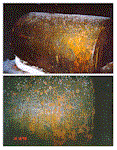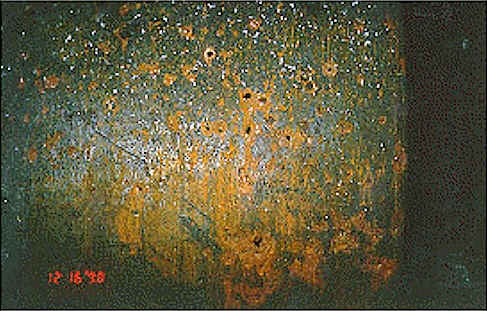Tanks.
But today we want to talk about storage tanks. Most hazardous and toxic products and wastes are stored in tanks. Some general nomenclature: Tanks divided according to their location into aboveground tanks and underground tanks. They are also divided by their contents: Hazardous waste, Hazardous non-waste, and Fuel. Different regulations apply:
| Location and Contents | Law |
| Underground and aboveground hazardous waste | RCRA |
| Underground hazardous (non-waste) and fuel | HSWA of RCRA |
| Aboveground hazardous and fuel | State and local |
(Forgot the acronyms? Go here.)
Tanks fail in several different modes:
The design of new tanks needs be done by a licensed engineer. Some of the key design features are: structural strength, materials compatibility, corrosion resistance, and piping and appurtenances. We'll talk briefly about these in turn.
Besides the obvious structural parameters of pressure, temperature, dead and live loading, the foundation including the soils beneath the tank must be considered.
Under the heading of corrosion, we should consider the compatibility of the materials being stored with the tank material. What is being stored is sometimes not completely known for hazardous wastes. Traces of chemicals are often very important. Also, bacteria can contribute to corrosion. The vast majority of failures of underground tanks and piping are due to simple electrolytic corrosion between the metal of the tank and the surrounding soil, sometimes enhanced by other sources of current.
The main underground tank materials are steel and fiberglass. The fiberglass is not as strong structurally as steel, but does not rust.
Types of appurtenances of importance are: Overfill gauges, containment devices (dikes, double walls), safety devices, ladders, access holes.
Here's a site that has examples of tanks. Go to CB&I, click on any of the listed appliacaitons for pictures of tanks.
Underground storage tanks
Let's consider the advantages of underground storage tanks with respect to aboveground tanks.
|
Underground storage tanks.
|
|
|
Advantages
|
Disadvantages |
| Saves real estate | Leaks may remain undetected |
| Can’t hit with fork lift | Volatilization of leaked product slowed |
| Minimize temperature variations | Leaked material is closer to ground water |
| Fire marshals like them | Tanks can float |
| Leaks of hazardous material stays underground ??? | They are highly regulated |
Here is a picture from the ADEC site that shows some underground tanks that were exhumed:

The red is rust. Here's the bottom picture in better detail.
 .
.
The black marks are holes. The owner of this tank did not realize it was leaking.
You can go the ADEC
site and see lots of tank details. Most of them refer to fuel storage tanks,
not hazardous waste tanks, but the principles are the same.
What we'll do next is run through some general items without a lot of detail,
then I have a set of pictures that will illustrate some of these concepts.
Construction of Underground Tanks.
Soils
Cave-ins are an important safety issues for the workers, because tanks almost
always require a deep hole or trench. The soil chemistry should be known, especially
pH, sulfide content, resistively, water table location and soil moisture. Location
of nearby metallic structures is important because of interference with cathode
protection. Backfill is very important. Special bedding is required to avoid
damage to the coating of the tank. The tank must be protected from floatation,
often by a concrete foundation tied to the tank with hoops. The backfill compaction
is very important, especially the backfill of the lower quadrant.
Cathode Protection
Metal must have corrosion resistant coating and be electrically isolated. There
are two main types of cathode protection, impressed current systems and
sacrificial anodes. The latter are zinc or magnesium blocks wired or attached
to the tank. Impressed current systems need a power source. Both types need
to be periodically tested, and special test wires must be installed with the
system. Besides the wires, a definite program to test and record is required. See the Wikipeda article sections Galvanic and Impressed.
Placing tank
Safety first. The coating and structure must be inspected as the tank is lowered.
Here's a site with photos of all aspects of tank installation and demolition.
Testing of system
The tanks and underground piping need to be pressure tested after all backfill
operations are complete, but before asphalt, etc. is placed over the top.
“Tightness testing”
Also known as “leak testing” is required periodically after installation.
(Secondary) Containment
If the primary containment is the tank itself, all tanks have to have some form
of secondary containment. Double wall tanks, dikes, liners, vaults, etc. are
all used. Besides the secondary containment, the system must be able to detect
spills or leaks. Except the double wall tanks, the systems needs the capacity
to include rainfall.
Underground fuel storage tanks are highly regulated. We won't spend time with
the details.
A very hazardous operation is the removal of old tanks. The tanks are often filled with vapors that are both health and explosion hazards. They usually have a gunk or sludge on the bottom that is a hazardous waste. Here is a report I wrote about a tank removal that went bad. It is a Word document.
Here starts a collection of tank photos, courtesy of Ron Broyles of the Corps
of Engineers. Each photo has some notes. These are high quality images, but
some may take 5 or 7 seconds to open. Tank Photos.
End of Submodule.